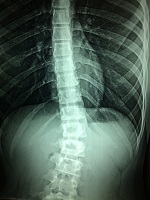
The idea that serious spinal cord injuries are untreatable may not be true any longer. Scientists have developed a "dancing molecules" approach. It can repair the spinal cord and reverse paralysis.
In earlier studies, scientists built artificial scaffolds made partly with short proteins called peptides to signal tissue regeneration. But the results weren't great.
The new study showed that when the movement of the signaling peptides is tuned just right, they can activate the cellular pathways important in spinal repair.
The researchers created a liquid that once injected into the spinal column, forms a gel composed of a network of nanofibers that mimics the natural matrix of the spinal column. The gel enhances the motion of the two signaling peptides which increases their ability to attach to cell receptors and activate those pathways.
One pathway stimulates the long threadlike parts of nerve cells which then cells to communicate helping regeneration.
The second signaling pathway stimulates the growth of supporting cells such as blood vessels. In just four weeks after a single injection of this gel into paralyzed mice, they could walk again.
The treatment has been through human clinical trials and safety testing. It was able to repair nerve damage and improved both sensations and mobility.
Similar approaches could one day be used to regenerate tissues in heart disease, liver failure and even some cancers.
You can now hear additional episodes on many of your favorite podcast providers - visit Buzzsprout to subscribe.
More Information
Bioactive scaffolds with enhanced supramolecular motion promote recovery from spinal cord injury
The signaling of cells by scaffolds of synthetic molecules that mimic proteins is known to be effective in the regeneration of tissues. Here, we describe peptide amphiphile supramolecular polymers containing two distinct signals and test them in a mouse model of severe spinal cord injury...
Fixing Spinal Cord Injuries With 'Dancing Molecules'
In a new injectable therapy that repairs spinal cord injuries, molecules form nanofibers that 'dance' around, making communication with cells to repair the injured spinal cord more likely...
A dynamic duo: Self-assembly of nanofibers facilitates the repair of spinal cord injury in mice
The extracellular matrix (ECM) is a vital component of all tissues that contributes to the physical and chemical cues that can affect cell fate. The design of materials to encourage the repair of tissue after injury is a long-standing goal of regenerative medicine. Supramolecular polymers based on reversible noncovalent interactions form fibrous materials that can act as simple but tailored ECM mimics. On page 848 of this issue, Álvarez et al. (1) show that tuning the dynamics of bioactive supramolecular polymers correlates with the degree of regeneration and functional outcome after acute spinal cord injury (SCI) in mice...